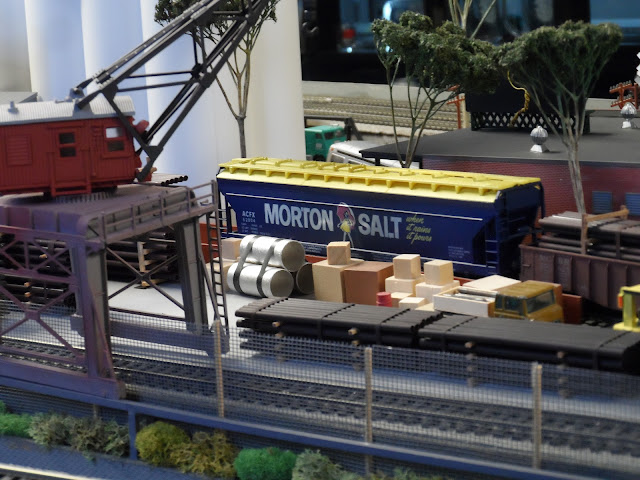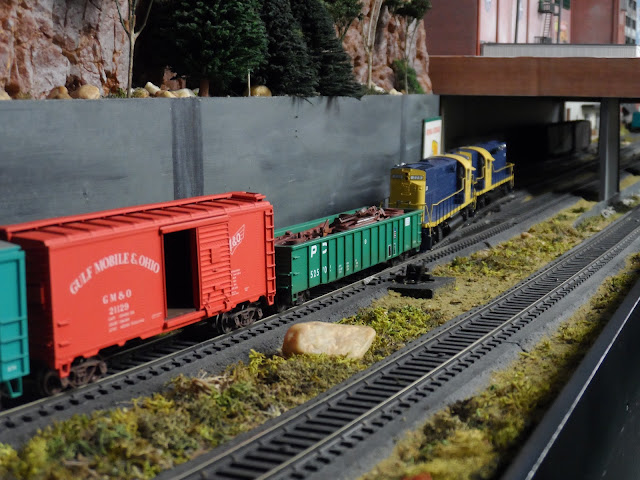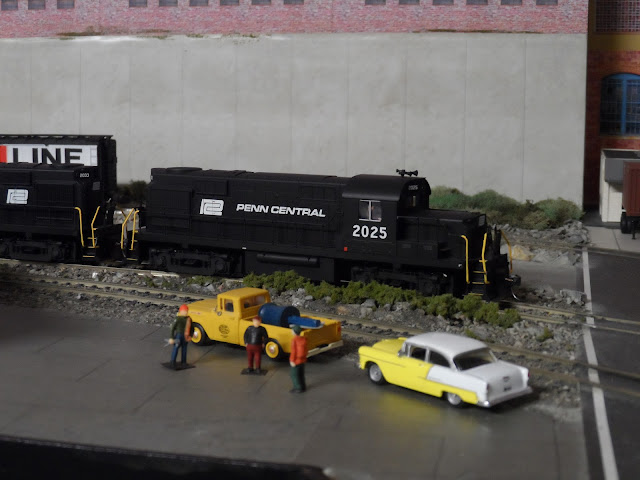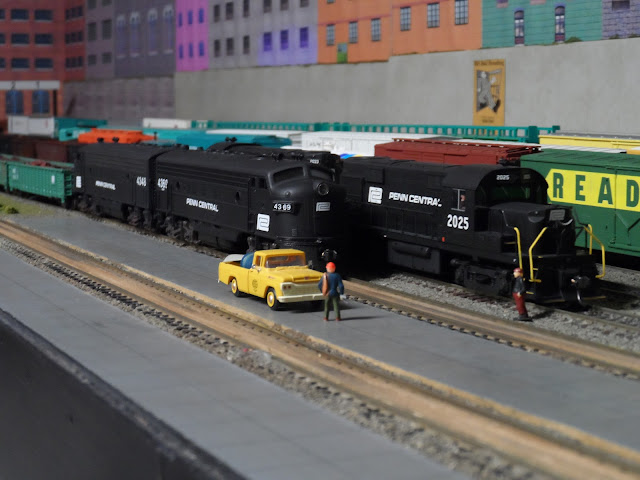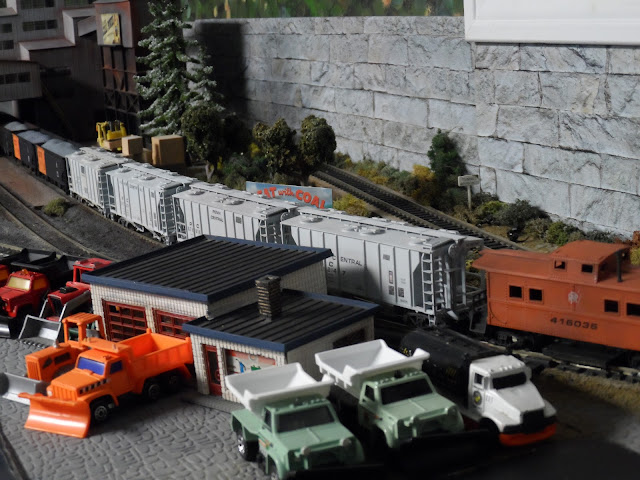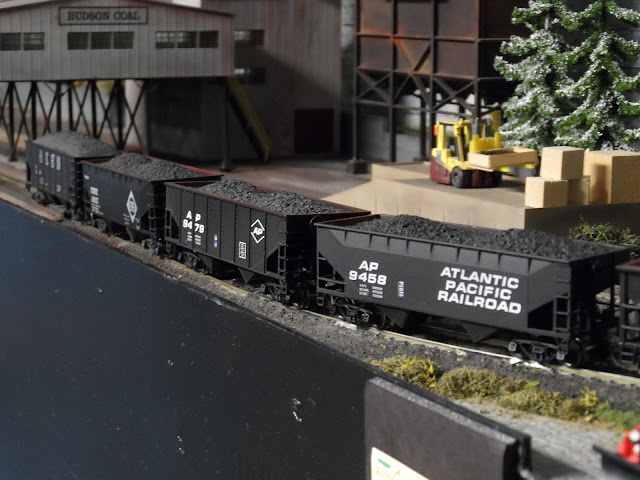Greetings All,
Welcome Back to PCCM #112
Our three layout virtual op with my layout interchanging freight traffic with Ralph's Kings Port Division and Sir Neal's Atlantic Pacific Railroad continues today with the dispatch of our outbound trains!!
Extra 3175 departs Terminal Yard.
Next stop Selkirk!!!
The GP20s are tied down in the engine terminal.
Back on the Bedford Secondary the almost forgotten BT-28 prepares to return to Terminal Yard as Train BT-28 before it outlaws. The new yardmaster is doing a good job so far balancing traffic movements and hours of service for the trainmen.
Train BT-28 heads back to Terminal Yard.The GP20s are tied down in the engine terminal.
Time to check in with the Empire Belt crew!!! The EBRR trainmen discuss their moves today with 1:87 senior engineer Sir Neal and conductor John working the Belt Job.
The Belt Job departs North Side Yard.
The first stop for the Belt Job is Neal's Lumber & Hardware to pull empty NYC boxcar 47062 and PC boxcar 77047 for their next PCCM loads.
The next move is to pull empty BAR boxcar 5226 and empty LV reefer 7120 from Empire Produce as 1:87 Emery photographs the action.The Belt Job heads west.
The Belt Job starts working the Walsh Steel Wool Products siding pulling two EBRR boxcars loaded with steel wool products for American Hardware Supply in Rock Ridge, NJ and TP&W boxcar 627 loaded with steel wool products for Boom's Ready Mix in West Mill, NY.
Getting pulled from Drywell Inks are empty NYC and LV boxcars. The NYC 80755 will be held at North Side Yard to be moved to it's next PCCM load. The LV 66392 will be heading back to the LV at Binghamton, NY.The Belt Job heads back to North Side Yard.
Once back in the yard Sir Neal sets up some non PCCM traffic for the Haydon Heights crew to pick up easily.
The Alco starts working Gervais Pipe & Fitting and couples onto KP&W and MCRR gondolas loaded with pipe for the Hudson Valley Ag Coop via the KP&W Williams Yard.PC Ralph and conductor Rocky head to the Haydon Heights Lead and the ALCO S4 currently on loan to the EBRR. The end cab switcher is being tested for future use and will be reported on in a future blog post.
An empty Morton Salt covered hopper is pulled from the Quaker Plant for return to Morton Salt in Rock Ridge, NJ for its next PCCM load.
Train HH-1 departs Haydon Heights for North Side Yard.
PC Ralph has coupled onto the non PCCM freight cars going to Haydon Heights and talks things over with Sir Neal and conductor John. Making their PCCM debut are the PC and NH covered hoppers.
Train HH-2 heads back to Haydon Heights.
After delivering the non PCCM cars the Alco S4 and caboose are tied down on the Haydon Heights lead as PC Ralph and Conductor Rocky head to the Empire Belt RR office.
A little while later North Side Yard is ready for the arrival of Long Island RR Train MA-3 from Fresh Pond.And here it comes now!!! The MA-3 is rolling into Bedford with PC gondola 525702 loaded with scrap metal for Kings Port Steel and empty GM&O boxcar 21129 heading to its next PCCM load along with non PCCM tonnage bringing up the rear.
Train MA-3 rolls thru Bedford to North Side Yard.LIRR engineer Jimmy Alco checks in with the EBRR guys as the C420s build up the air for the train heading back to Fresh Pond.
LIRR Train MA-4 heads back to Fresh Pond with non PCCM traffic.Next stop Fresh Pond!!
Back in North Side Yard PC Ralph is boarding the 6294 and will take Train EB-2 to Terminal Yard. I think he's happy to be in the saddle of some serious horsepower!
Train EB-2 heads to Terminal Yard.PC Ralph checks in with the Terminal Yard gang as he reclaims his caboose.EBRR Train EB-3 departs Terminal Yard caboose light.
The Terminal Yard crew makes its plans to get the last PCCM trains to Selkirk.
Big Mike has the yard set up for train SK-5 (LV Reefer), SK-7 (EBRR Boxcar) and PCCM traffic to be held for PCCM loading.
It's time to assign the motive power and call the road crews. Overworked hostler Wet Willy has two GP40s in his stable ready to go.
PC GP40 3007 (Ex NYC 3007) known locally as "the Growler" is coupled onto the SK-5 freight consist.
Train SK-5 departs Terminal Yard.
Next Stop Selkirk!!!
Sir Neal and conductor John, who arrived with EBRR Train EB-4, confer with Superintendent Shore as they watch Train SK-7 prepare to depart.Train SK-7 departs Terminal Yard.
Next Stop Selkirk!!!
This closes out the Outbound portion of PCCM 112 on the NYCTL.
Be sure to catch the PCCM action on PC Ralph's Kings Port Division and Sir Neal's Atlantic Pacific Railroad.
Thanks for reading and watching!!!
See you Friday!!!













